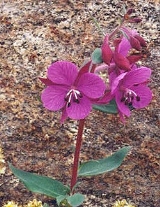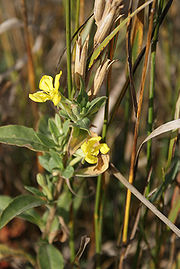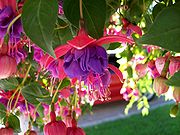
Onagraceae
Encyclopedia
Onagraceae, also known as the Willowherb family or Evening Primrose family, are a family
of flowering plant
s. The family includes about 640-650 species of herb
s, shrub
s, and tree
s in 20-24 genera
. The family is widespread, on every continent from boreal
to tropical regions.
The family includes a number of popular garden
plants, including evening primroses (Oenothera
) and fuchsia
s (Fuchsia). Some, particularly the willowherbs (Epilobium
) are common weed
s in gardens, e.g. Fireweed
.
The family is characterised by flower
s with usually four sepal
s and petal
s; in some genera (e.g. Fuchsia), the sepals are as brightly coloured as the petals, giving the impression of a flower with eight petals. The seed
The seed
s are very small, in some genera (e.g. Epilobium) with a tuft of down and wind
-dispersed, in others (e.g. Fuchsia), in a juicy berry
and dispersed by bird
s. The leaves
are commonly opposite or whorled, but are spirally arranged in some species; in most, they are simple and lanceolate in shape. The pollen grains in many genera are loosely held together by viscin threads, meaning that only bees that are morphologically specialized to gather this pollen can effectively pollinate the flowers (it cannot be held effectively in a typical bee scopa
). Accordingly, nearly all of the bees that visit onagraceous flowers are floral specialists (oligoleges).
 The family is named after the genus Onagra (now known as Oenothera
The family is named after the genus Onagra (now known as Oenothera
) in 1836 by J. Lindley in the second edition of Nat. Syst. Bot.
Family (biology)
In biological classification, family is* a taxonomic rank. Other well-known ranks are life, domain, kingdom, phylum, class, order, genus, and species, with family fitting between order and genus. As for the other well-known ranks, there is the option of an immediately lower rank, indicated by the...
of flowering plant
Flowering plant
The flowering plants , also known as Angiospermae or Magnoliophyta, are the most diverse group of land plants. Angiosperms are seed-producing plants like the gymnosperms and can be distinguished from the gymnosperms by a series of synapomorphies...
s. The family includes about 640-650 species of herb
Herb
Except in botanical usage, an herb is "any plant with leaves, seeds, or flowers used for flavoring, food, medicine, or perfume" or "a part of such a plant as used in cooking"...
s, shrub
Shrub
A shrub or bush is distinguished from a tree by its multiple stems and shorter height, usually under 5–6 m tall. A large number of plants may become either shrubs or trees, depending on the growing conditions they experience...
s, and tree
Tree
A tree is a perennial woody plant. It is most often defined as a woody plant that has many secondary branches supported clear of the ground on a single main stem or trunk with clear apical dominance. A minimum height specification at maturity is cited by some authors, varying from 3 m to...
s in 20-24 genera
Genus
In biology, a genus is a low-level taxonomic rank used in the biological classification of living and fossil organisms, which is an example of definition by genus and differentia...
. The family is widespread, on every continent from boreal
Boreal ecosystem
The term boreal is usually applied to ecosystems localized in subarctic and subantarctic zones, although Austral is also used for the latter....
to tropical regions.
The family includes a number of popular garden
Garden
A garden is a planned space, usually outdoors, set aside for the display, cultivation, and enjoyment of plants and other forms of nature. The garden can incorporate both natural and man-made materials. The most common form today is known as a residential garden, but the term garden has...
plants, including evening primroses (Oenothera
Oenothera
Oenothera is a Genus of about 125 species of annual, biennial and perennial herbaceous flowering plants, native to North and South America. It is the type genus of the family Onagraceae, the Evening Primrose Family. Common names include evening-primrose, suncups, and sundrops.The species vary in...
) and fuchsia
Fuchsia
Fuchsia is a genus of flowering plants that consists mostly of shrubs or small trees. The first, Fuchsia triphylla, was discovered on the Caribbean island of Hispaniola in 1703 by the French Minim monk and botanist, Charles Plumier...
s (Fuchsia). Some, particularly the willowherbs (Epilobium
Epilobium
Epilobium is a genus in the family Onagraceae, containing about 160-200 species of flowering plants with a worldwide distribution. They are generally abundant in the subarctic, temperate and subantarctic regions, whereas in the subtropics and tropics they are restricted to the cool montane biomes,...
) are common weed
Weed
A weed in a general sense is a plant that is considered by the user of the term to be a nuisance, and normally applied to unwanted plants in human-controlled settings, especially farm fields and gardens, but also lawns, parks, woods, and other areas. More specifically, the term is often used to...
s in gardens, e.g. Fireweed
Fireweed
Epilobium angustifolium, commonly known as Fireweed , Great Willow-herb , or Rosebay Willowherb , is a perennial herbaceous plant in the willowherb family Onagraceae...
.
The family is characterised by flower
Flower
A flower, sometimes known as a bloom or blossom, is the reproductive structure found in flowering plants . The biological function of a flower is to effect reproduction, usually by providing a mechanism for the union of sperm with eggs...
s with usually four sepal
Sepal
A sepal is a part of the flower of angiosperms . Collectively the sepals form the calyx, which is the outermost whorl of parts that form a flower. Usually green, sepals have the typical function of protecting the petals when the flower is in bud...
s and petal
Petal
Petals are modified leaves that surround the reproductive parts of flowers. They often are brightly colored or unusually shaped to attract pollinators. Together, all of the petals of a flower are called a corolla. Petals are usually accompanied by another set of special leaves called sepals lying...
s; in some genera (e.g. Fuchsia), the sepals are as brightly coloured as the petals, giving the impression of a flower with eight petals.

Seed
A seed is a small embryonic plant enclosed in a covering called the seed coat, usually with some stored food. It is the product of the ripened ovule of gymnosperm and angiosperm plants which occurs after fertilization and some growth within the mother plant...
s are very small, in some genera (e.g. Epilobium) with a tuft of down and wind
Wind
Wind is the flow of gases on a large scale. On Earth, wind consists of the bulk movement of air. In outer space, solar wind is the movement of gases or charged particles from the sun through space, while planetary wind is the outgassing of light chemical elements from a planet's atmosphere into space...
-dispersed, in others (e.g. Fuchsia), in a juicy berry
Berry
The botanical definition of a berry is a fleshy fruit produced from a single ovary. Grapes are an example. The berry is the most common type of fleshy fruit in which the entire ovary wall ripens into an edible pericarp. They may have one or more carpels with a thin covering and fleshy interiors....
and dispersed by bird
Bird
Birds are feathered, winged, bipedal, endothermic , egg-laying, vertebrate animals. Around 10,000 living species and 188 families makes them the most speciose class of tetrapod vertebrates. They inhabit ecosystems across the globe, from the Arctic to the Antarctic. Extant birds range in size from...
s. The leaves
Leaf
A leaf is an organ of a vascular plant, as defined in botanical terms, and in particular in plant morphology. Foliage is a mass noun that refers to leaves as a feature of plants....
are commonly opposite or whorled, but are spirally arranged in some species; in most, they are simple and lanceolate in shape. The pollen grains in many genera are loosely held together by viscin threads, meaning that only bees that are morphologically specialized to gather this pollen can effectively pollinate the flowers (it cannot be held effectively in a typical bee scopa
Scopa (biology)
The term scopa is used to refer to any of a number of different modifications on the body of a non-parasitic bee that form a pollen-carrying apparatus. In most bees, the scopa is simply a particularly dense mass of elongated, often branched, hairs on the hind leg...
). Accordingly, nearly all of the bees that visit onagraceous flowers are floral specialists (oligoleges).

Oenothera
Oenothera is a Genus of about 125 species of annual, biennial and perennial herbaceous flowering plants, native to North and South America. It is the type genus of the family Onagraceae, the Evening Primrose Family. Common names include evening-primrose, suncups, and sundrops.The species vary in...
) in 1836 by J. Lindley in the second edition of Nat. Syst. Bot.
Subfamily Onagroideae
Tribe Circaeeae
Tribe Epilobieae
Tribe Gongylocarpeae
Tribe Hauyeae
Tribe Lopezieae
Tribe Onagreae |
|

